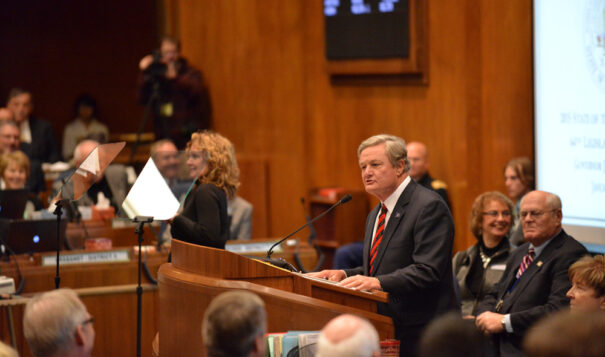News Based on facts, either observed and verified directly by the reporter, or reported and verified from knowledgeable sources.
Former governor frustrated with federal bureaucracy during DAPL protests
 Former Gov. Jack Dalrymple delivers the State of the State address in 2015 at the state Capitol. He testified in federal court on Friday about the Dakota Access Pipeline protests, which occurred during the final months of his tenure. (Courtesy of State Historical Society of North Dakota. SHSND 31843)
Former Gov. Jack Dalrymple delivers the State of the State address in 2015 at the state Capitol. He testified in federal court on Friday about the Dakota Access Pipeline protests, which occurred during the final months of his tenure. (Courtesy of State Historical Society of North Dakota. SHSND 31843)
Federal trial anticipated to last until mid-March
The public may never get a satisfying explanation as to why federal agencies refused North Dakota additional support during the Dakota Access Pipeline protests, former Gov. Jack Dalrymple said Friday.
“Bureaucracy is a great place to hide,” he said after wrapping up testimony in U.S. District Court in Bismarck.
North Dakota is asking a judge to order the U.S. to pay $38 million to reimburse the money it spent policing the DAPL protests — an expense the state claims directly resulted from poor decision making by federal officials.
Attorneys for the United States have countered that North Dakota has exaggerated the cost of the demonstrations and that the federal government’s actions did not influence the course of the protests. The U.S. has also said North Dakota is unfairly trying to blame the federal government for events that were not its responsibility.
The trial, heard by U.S. District Court Judge Daniel Traynor, began Feb. 15. The hearing is scheduled to continue through the first two weeks of March.
Activists came to show solidarity with the Standing Rock Sioux Tribe, which opposed the pipeline because of concerns for its water supply. Demonstrators from several states and countries camped on federal, private and tribal land near the pipeline construction site in 2016 and 2017. The state estimates in court filings that at the height of the protest’s popularity, thousands were living in the camps.
The main DAPL protest camp was on land managed by the U.S. Army Corps of Engineers.
State and local police were the primary law enforcement presence at the protests, though witnesses for the state have testified that North Dakota asked repeatedly for support from federal agencies.
The state’s working relationship with federal agencies seemed to sour around September 2016, Dalrymple said during his testimony. On Sept. 9, the Department of Justice, Department of the Interior and Department of the Army issued a joint statement announcing that it was suspending construction of the pipeline. The Corps has jurisdiction over the segment of the pipeline that crosses under the Missouri River north of the Standing Rock Sioux Reservation.
Dalrymple, who was governor until January 2017, said the decision blindsided him.
“Nobody had any idea what needed to be reconsidered,” he said.
The three federal agencies put both the pipeline and the protesters in a state of limbo, Dalrymple said. That’s one of the main reasons why the state felt entitled to greater support from the U.S., he added.
“If the federal government was going to ask us to put this project on pause,” he said, “we now considered it their responsibility to help us.”
As the protests grew in size, Dalrymple called on Attorney General Loretta Lynch and Department of the Interior Secretary Sally Jewell for financial assistance as well as backup from federal law enforcement.
He also sought help from President Barack Obama and the FBI.
“For the most part, the response was minimal,” Dalrymple said.
He didn’t always hear back from federal officials, but when he did, they simply stated they did not have any resources available, he said.
Morton County Sheriff Kyle Kirchmeier testified earlier that week that he had sent similar requests to Obama and members of his cabinet, as well as to president-elect Trump in December 2016. None were successful, Kirchmeier said.
Dalrymple isn’t the only governor expected to testify in the trial — Gov. Doug Burgum is slated to take the stand Monday.
John Henderson, an Army Corps of Engineer liaison during the DAPL protests, is also scheduled to appear as a witness early next week.
North Dakota has already been given $25 million as payment for managing the protests. Of that, $10 million came from the U.S. Department of Justice in 2017, and the other $15 million came from pipeline developer Energy Transfer Partners.
